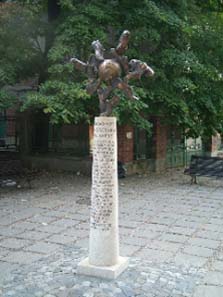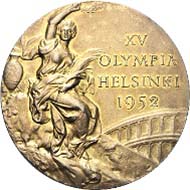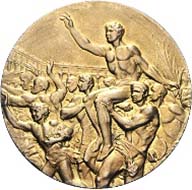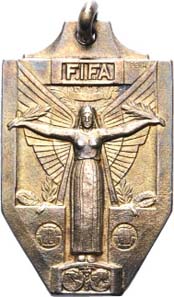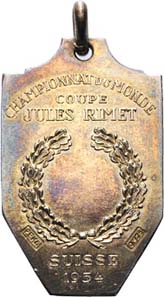On November 22, 2011, the auction house Rapp in Wil will auction off a numismatic relic of one remarkable event in the history of sports the whole of Germany recalls until the present day. It was July 4, 1954, when the German national football team defeated the hotly favored Hungarians 2:3 at the Wankdorf Stadium in Bern. This unexpected victory is sometimes referred to as the true beginning of the German Wirtschaftswunder because the euphoria it triggered in Germany ended the resignation after World War II.
“Aranycsapat”, the “Mighty Magyars”. Sculpture by Kalmár Márton. Source: Wikipedia.
The two medals offered at Rapp were once owned by László Budai II, a Hungarian international, who was a member of the legendary “Mighty Magyars”. They bear witness to a flight of the Hungarian football as it was experienced never again. “Sighthound” Horst Eckel, striker of the German national team in 1954, described the successes of the Mighty Magyars as follows: “The Hungarian national team of the 1950s around team captain Ferenc Puskás developed into one of the best football teams ever. Taken into account all matches and the overall performance, it surely was the best football team of the world in our days. It was rightly called “The Golden Team”. It is known by name to many football fans up to the present day.
The streak began on June 4, 1950, when they beat Poland 5:2 in Warsaw. The first big title this so-called Magical Team celebrated in 1952 at the Olympic Games in Helsinki when they defeated Yugoslavia 2:0 in the final and thus won the gold medal. Next time they succeeded in 1953, when they won the European Cup of the national football teams that was held since 1948. The European Cup was a predecessor of the World Cup, in which Italy, Austria, Switzerland and the Czech Republic, besides Hungary, participated.
The decisive last game was won on May 17, 1953, in Rome against Italy 3:0 with 80,000 spectators watching. Having scored 10 goals, Puskás became top scorer of the competition. On November 25, 1953, the probably most spectacular match of the Golden Team followed, which soon was referred to as “Match of the Century” or simply The 6:3. At Wembley Stadium Hungary met the English team, in home matches unbeaten so far. The outcome was a complete victory, 6:3. The Hungarians presented thrilling attacking football and a 4-2-4 lineup which was regarded revolutionary in those days. The usual formation of the Golden Team, however, was 3-2-5, hence with five strikers.
The Hungarian national football team, therefore, were favorites when they travelled to the World Cup in 1954 to Switzerland. They survived the group stage without any problems, had outclassed Germany in the second game 8:3. In the quarter final vice world champion Brazil was beaten, in the semi final world champion Uruguay, 4:2 in every case. In the final in Bern they faced the German team a second time. In a dramatic final the Hungarians lost 2:3, entirely unexpectedly, after they had been up, 2:0. That was the first loss of the Golden Team for four years. It prompted disappointment and resentment in the whole of Hungary. The team nevertheless started to be on a roll again, until 1956, when they lost against Turkey.”
Gold medal of the Olympic Games 1952 in Helsinki from the possession of László Budai. The item will be auctioned off on November 22, 2011, at the company Rapp in Wil and is estimated at CHF 4,000 to 6,000.
The auction house Rapp is able to offer the Olympic gold medal László Budai won in Helsinki in 1952. It was designed by the Italian artist Giuseppe Cassioli and the Finn Aukusti Tuhka. On its obverse it shows an antique-like sitting Victoria holding the victor’s laurels in her right hand and the victor’s palm in her left arm. In the background an antique-like building can be seen which is interpreted as Colosseum. On the reverse males in heroic nudity carry the likewise naked victor on their shoulders. The victor holds the palm in his left hand and has raised his right one in an addressing gesture.
Of course, the “gold medal” isn’t made of pure gold but of gilded silver. The material for the silver and the gold medal was donated then by the Finnish steel producer Vuoksenniska Oy.
The medal wasn’t manufactured by the Finnish Mint, as could be expected, but by the still existing producer of jewelry, Kultakeskus Oy.
A pre-sale price tag of CHF 4,000 to 6,000 CHF carries the silver medal László Budai was awarded in 1954 in Bern. It will be auctioned off as well on November 22, 2011.
Considerably smaller is the silver medal that was awarded in 1954 in Hungary. Even though Budai didn’t take part in the final, being a team member he nevertheless received one of the sought-after decorations. Below the inscription FIFA the obverse shows an Egyptian-like goddess of victory with wings that holds victor’s palms in both hands and stands on a pedestal with a globe on it. The latter stands for the Coupe Jules Rimet, presented to the current world champion until 1970. The victor’s laurels are depicted above her head and – both in the shape of a wreath and a branch – in a small niche in front of which she shows herself. In the lower third of the medal two footballs are depicted.
The reverse shows an oak wreath and the inscription world championship in French above, below Coupe Jules Rimet, FIFA President 1921-1954. Rimet is considered inventor of the World Cup, renamed into Coupe Jules Rimet in 1950 in his honor. Below the venue and the year are stated as well as the punches PEKA and 0,923 for the silver content.
Paul Kramer from Neuchatel created this medal.
László Budai, born on July 19, 1928, in Budapest, originally played for Ferencváros Budapest, the football team of the 9th district of Budapest, record champion and most successful club of Hungary, which – with Budai as player – became Hungarian Champion in 1949. When the Communists assumed power in Hungary, Budai was signed for Honvéd. Honvéd was the football club of the Hungarian army that permitted its players to concentrate entirely on their training – that wasn’t the rule in the 1950s. In this club, Budai played together with Ferenc Puskás, Sándor Kocsis, József Bozsik and Zoltán Czibor. They formed the backbone of the “Golden Team”, nicknamed “Mighty Magyars” in the English-speaking area.
In 1956, however, everything changed. When the Revolution in Hungary was brutally crushed, the Honvéd team was in Spain for an away match. Most of the players accepted an offer of Real Madrid to stay there. Budai refused and returned home to Budapest. His impact on the Hungarian football was so big that the stadium of Budapest today bears his name. In 1983, the famous footballer died whose medals will be auctioned off on November 22, 2011, at Rapp in Wil.
If ou want to watch the decisive moments of this thrilling final, please click here.
More information on the auction you can find here.
If you want to page through the catalogue, click here.





